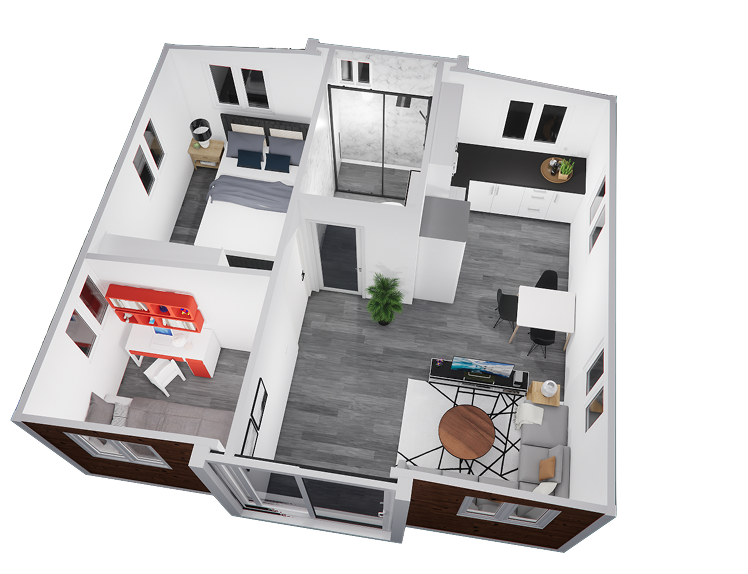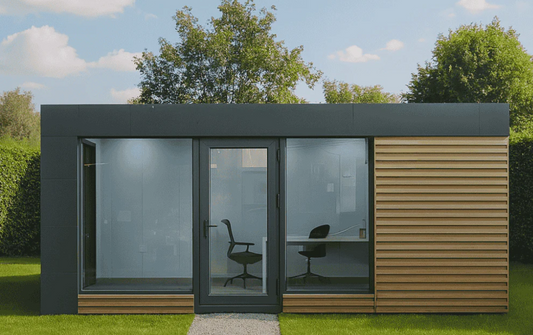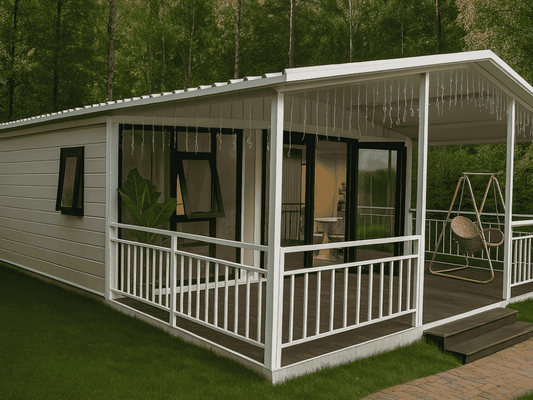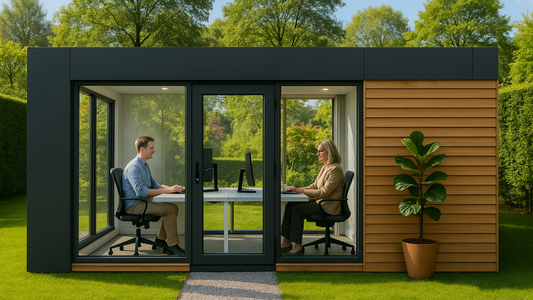Building your own place is a huge milestone – but what’s the best way to do it? As a first-time home buyer, an Airbnb host eyeing a backyard rental, or someone planning an accessory dwelling unit (ADU), you’ve probably heard about prefab homes (a.k.a. modular or prefabricated homes) and wondered how they stack up against traditional stick-built construction. In this post, we’ll chat through the key differences in process, time, cost, and complexity, as well as foundations and utilities. We’ll also weigh the pros and cons of each approach in plain English. By the end, you’ll see why so many people are excited about prefab homes – and how companies like Home Drop are making home building simpler and more affordable than ever.
Process & Timeline: Factory Fast vs. On-Site Slow
Traditional construction means building on-site, piece by piece. Think of it as assembling a house from scratch in your yard: laying the foundation, framing the walls, running electrical and plumbing, insulating, drywalling, and so on. All these steps happen sequentially, and progress can be slow – often taking anywhere from half a year to well over a year to finish a typical house (around 6–16 months is common) . Why so long? On-site projects can face delays from bad weather, scheduling conflicts with subcontractors, or waiting on materials. For example, heavy rain or snow can halt work for days or weeks. In short, a traditional build is a bit like cooking a multi-course meal by yourself – lots of moving parts that have to come together on site, often one after the other.
Prefab homes, on the other hand, flip the script on the process. Prefabricated construction means most of the building is done in a factory while your site is prepared in parallel. The house components (often modules or sections) are built indoors in a controlled environment. This off-site building approach avoids weather delays and can speed up construction time by as much as 50% according to industry studies . In fact, once the modules are ready and delivered, they can be assembled on your property in a matter of weeks. It’s not uncommon for a modular home to go from delivery to move-in in around 6–8 weeks (after the foundation is done) . Imagine ordering a home that arrives almost complete – like a giant piece of IKEA furniture that just needs snapping together (don’t worry, the prefab company handles the assembly!). The simultaneous factory construction and on-site prep can drastically shorten your overall timeline. As one modular builder put it, traditional homes can take months (or even years) to finish, while a modular home is done in a fraction of the time .

Bottom line on timeline: If you’re in a hurry – say you want that Airbnb rental up and running by summer – prefab offers a much faster path. Fewer weather hold-ups and a streamlined process mean you could be living in your new home or hosting guests in weeks instead of many months. Traditional builds are a marathon, not a sprint, and require more patience (and perhaps more interim housing plans while you wait).
Cost Comparison: Up-Front Budget vs. Potential Savings
Cost is often the make-or-break factor for home projects. Traditional stick-built homes tend to have higher price tags per square foot. Recent data puts the national average cost of a new site-built home around $150 per square foot (excluding land). That means a typical 2,000 sq ft house could run about $300k just for construction. And in many parts of the country, costs are even higher – $200+ per sq ft in high-demand areas is not unusual . On top of that, on-site builds can be notorious for budget creep: a rain delay here, a material price spike there, a few upgrades or changes mid-build, and suddenly you’re spending more than expected. With a traditional project, you’re also paying for extensive on-site labor over many months, which adds up. Surprises (like discovering the soil needs extra reinforcement, or framing taking longer than planned) can further inflate the cost.
Prefab homes can offer a more budget-friendly route. Because so much of the construction is done in a factory with efficient use of materials and labor, prefab builds often come out cheaper for the same size house. There’s less material waste (factory precision means they don’t create as much scrap lumber or drywall waste as a typical site build ) and bulk purchasing of materials keeps costs down. Labor is optimized too – workers in the factory can assemble components faster and without weather interruptions. Industry leaders estimate that choosing modular construction can save around 20% or more on overall building costs compared to traditional methods . That’s a significant chunk of savings! Plus, a shorter build time also means lower carrying costs (you’re paying for fewer months of labor, and can move in or start earning rental income sooner). While exact savings vary by project, the cost per square foot for prefab is generally lower. Many prefab or modular home packages range from about $80 to $120 per square foot, depending on customization . Some basic prefab units can be even less. For instance, we’ll highlight Home Drop’s Grand Oasis model below – it comes out to roughly $66 per sq ft, which is less than half the cost of an average traditionally built home of the same size!

Another budget advantage of prefab is price predictability. Prefab companies usually give you a set price for the home (minus land and site work) upfront. Since the design and specs are decided early and much of the work is repeatable, there’s less risk of surprise add-ons. In contrast, with a stick-built project, change orders or delays can require extra funds. Of course, prefab isn’t “cheap” – you still have to pay for quality construction, transport, and installation – but it often delivers more bang for your buck. And if you’re building a smaller structure like an ADU or guest house, prefab can make a project financially feasible where a custom on-site build might be too costly for the size.
Foundations and Utilities: No Skipping the Basics
Whether you go prefab or traditional, every house needs a foundation and utility hookups. This is one area where the two approaches are more similar than you might think. For a traditional build, the process typically starts with laying a foundation – be it a concrete slab, crawlspace, or basement. Once the structure is up, contractors will run the plumbing lines, electrical wiring, and HVAC ducts as they build, eventually connecting everything to the municipal utilities or well/septic systems as appropriate. All of this is accounted for in the construction schedule (though sometimes utility hook-ups or permits can cause delays if you hit a snag).

For a prefab home, you’ll also need to prepare the site before the house arrives. That means building a foundation on your lot for the prefab modules to sit on (usually a slab or poured concrete footers and a crawlspace/basement, similar to any other house). This site prep can happen while your home is being built in the factory. By the time your prefab units are delivered, the foundation is ready to go – an essential step so the installation crew can place and secure the modules immediately.
After the prefab modules are placed on the foundation, utilities need to be connected up just like any house. The good news is that prefab homes come with all the internal wiring and plumbing pre-installed in the walls and floors. Think of it like this: the kitchen and bathrooms are already plumbed, the outlets already wired – they just need to be linked to your external utility lines. A local electrician will connect the main power to your breaker box, a plumber will hook up water and sewer lines to the pre-plumbed connections, and so on . If you’re in a remote area, this might include setting up a well or septic system (just as a traditional build would). All the usual permits (building, electrical, plumbing, etc.) apply equally to prefab projects as they do to site-built homes – you aren’t escaping the paperwork by going prefab! The prefab manufacturer typically works with local inspectors to get the modules approved to code, and then inspectors will also sign off on the on-site installation and hookups.
One thing to note: foundation and utility work is an extra cost to budget for in a prefab project. In a traditional build, it’s all rolled into the overall construction cost, whereas with prefab you often pay the prefab company for the house and a local contractor separately for foundation/utility prep. But either way, you’re paying for a foundation and the pipes/wires – there’s no avoiding that step. The key difference is simply when and how it happens (prefab = before delivery, traditional = during construction). Both methods result in a home that’s fixed to the ground and connected to the grid. And once that prefab home is bolted down and the power and water are flowing, it’s basically indistinguishable from a “regular” house in function.
Advantages and Disadvantages of Each Approach
Every building method has its highs and lows. Let’s break down, in a nutshell, where prefab homes shine and where traditional stick-built construction still has the edge.
Prefab Home Advantages:
-
Speedy construction: As discussed, factory building and parallel site prep dramatically cut build times. You can go from zero to finished home in a few months or less – a huge plus if you’re eager to move in or start renting out that unit quickly .
-
Lower costs: Prefabs often cost less per square foot thanks to efficient manufacturing. You save on labor and materials (factories buy in bulk and reduce waste), and shorter build times mean fewer labor hours billed . Overall project costs can be around 20% lower than traditional builds in many cases .
-
Quality control: Building indoors in a controlled environment means no rain-soaked lumber or warped materials. Factories have strict quality checks, so modules are built to precise specs. This can lead to high construction quality with fewer on-site surprises (every unit is inspected before it ever leaves the factory) .
-
Less hassle: For an owner, prefab can be a more turnkey experience. The house arrives mostly complete – no need to coordinate dozens of subcontractors for every trade. This “one-stop-shop” approach (especially if the prefab company handles installation) makes the project easier to manage, even for newbies.
-
Eco-friendly and less disruption: Shorter construction time and less on-site work means reduced disturbance to your property (and neighbors). Plus, factories can recycle scraps and optimize energy use, so prefab can be a greener choice with a smaller carbon footprint than traditional building .

Prefab Home Disadvantages:
-
Design limitations: Prefab homes are getting more customizable, but they still have to be built in modules that fit on a truck. That can mean some limitations in layout or size. If you want a very unconventional design or layout, traditional might handle it better. (That said, many modern prefab companies offer a variety of styles – so it’s not all cookie-cutter by any means).
-
Transportation & site access: Your prefab house (or sections of it) must be shipped to your land. If you live up a tiny mountain road or have lots of trees or power lines in the way, delivery can be tricky or require special equipment. There’s also a cost for transporting large modules and possibly renting a crane to place them. These logistics are usually figured out in advance, but they’re a factor to consider (whereas a stick-built house brings materials in piece by piece more easily).
-
Less flexibility during build: With a site-built home, you might decide mid-project to, say, move a wall or change a room size (though it’s costly, it’s doable). With prefab, the major structural decisions are locked in once fabrication starts. In other words, changes or customizations need to be decided upfront, which requires a bit more planning commitment.
-
Financing or local code hurdles: This isn’t as big an issue now as in the past, but occasionally you’ll find a lender less familiar with modular homes, or an old-fashioned zoning rule that complicates placing a prefab or container home. In most areas, prefab homes appraise and finance the same as traditional homes, but a little extra homework might be needed to smooth the process.
Traditional Construction Advantages:
-
Complete design freedom: Building on-site stick-by-stick allows for fully custom designs. Want an odd-shaped floor plan or specific architectural detail? A skilled architect and builder can likely make it happen. You’re not constrained by module dimensions, so traditional is ideal for unique or highly customized dream homes.
-
Changes and tweaks are possible: While you definitely pay for changes, a traditional build can adapt on the fly more easily. If during framing you realize you’d prefer a window in a different spot, or you decide to add an outlet, it’s typically easier to adjust in a site-built scenario than in a pre-made module.
-
Widely available contractors: Almost every town has experienced builders and contractors for traditional homes. You might have more choices of who to hire, and you can be more hands-on in selecting specialists (like that artisan who does custom tile). Prefab, conversely, often ties you to a specific manufacturer for the main build.
-
Proven track record: Traditional homes have been built for centuries – any local inspector, appraiser, or lender understands them. There’s comfort in the familiar. If you’re building a forever home with very specific vision, the traditional route gives you maximum control (as long as you have the budget and time).
Traditional Construction Disadvantages:
-
Longer build time: No surprise here – a custom on-site build is usually much slower than prefab. You’re looking at many months of construction, which means more carrying costs (e.g. if you’re paying a construction loan or renting a place to live during the build) and simply more waiting before you can enjoy the home .
-
Higher cost and risk of overages: Labor and material costs for traditional builds are generally higher, and the likelihood of cost overruns is significant. Unexpected problems (like rotten soil, material price spikes, or contractor delays) can blow up your budget. Per square foot, you’re often paying a premium for the bespoke, on-site process .
-
Project management complexity: A site build has many moving parts to coordinate – architects, engineers, permits, multiple subcontractors (foundation, framers, plumbers, electricians, roofers, etc.). If you hire a general contractor, they handle this, but you’re still indirectly dealing with a more complex operation than ordering a prefab. More complexity can mean more stress and chances for miscommunication or mistakes.
-
Weather and site disruption: Building outside means dealing with whatever Mother Nature throws at you – which can cause delays and work quality issues. Your property will also be an active construction zone for a long period. For owners in dense neighborhoods or those adding an ADU, this could mean months of noise, mess, and crews coming and going. Prefab significantly reduces on-site disruption time.

Home Drop’s Prefab Examples: Grand Oasis and Summit Villa
To put all this in perspective, let’s look at a real prefab offering. Home Drop is a company that specializes in modern prefab homes, and they have some great examples that highlight the value of going prefab. The Grand Oasis is one of Home Drop’s popular models – it’s a 760 sq ft home (plenty of space for a comfortable 1-3 bedroom layout) and comes in at an average cost of about $50,000. That works out to roughly $66 per square foot, which is incredibly affordable compared to the traditional $150+ per sq ft for a comparable small home . In other words, the Grand Oasis gives you a full house for the price-per-foot of a bargain renovation. Despite the low cost, it’s a complete, livable home that’s built to the same code standards as any site-built house – and it’s move-in ready the day it arrives. For someone looking to add an Airbnb rental unit in the backyard or a cozy cottage to live in, the Grand Oasis shows how prefab can make it possible on a tight budget. (Imagine recouping your investment in a few years of Airbnb income, thanks to that low upfront cost!).
What do you get with a prefab like the Grand Oasis? Home Drop’s design comes delivered with all the finishes – walls, flooring, plumbing, electrical, kitchen, bathroom – all done at the factory. You’d arrange for the foundation and utility hookups as we discussed, and then the home is literally dropped into place and connected. The speed and simplicity here mean less stress for the owner. Instead of a 9-month construction zone in your yard, it might be a few weeks of foundation work, then one fine delivery day, and a bit of finish work hooking up utilities. It’s almost like magic watching a fully formed house unfold or crane into position!
Home Drop also offers larger designs, including two-story models. For instance, the Summit Villa is a Home Drop prefab that adds a second level – doubling the space from around 760 sq ft to as much as 1,600 sq ft. This shows that prefab isn’t limited to tiny homes; you can get spacious, family-sized houses, or in the case of Summit Villa, perhaps a roomy vacation home with bedrooms upstairs. The variety of models (from compact studios to two-story villas) highlights prefab’s flexibility. Whether you need a small ADU or a full-sized home, companies like Home Drop likely have a model to fit. And because these units are modular, you can often combine or expand them for more space down the line.

By featuring the Grand Oasis and Summit Villa, we can see that prefab homes can span a range of sizes and styles – all while keeping the process simple and costs relatively low. Home Drop’s homes are built for “real living” (as they advertise), with sturdy construction for all climates (yes, prefab homes can handle snow, wind, and weather just fine). The end result doesn’t look like a temporary trailer or a shipping container – it looks and functions like a modern house, because it is a house, just one that took a smarter path from factory to front door.
Conclusion: The Modern Appeal of Prefab
Choosing how to build your home is a personal decision – and traditional construction and prefab both have their place. But for many modern home buyers and builders, prefab is an increasingly attractive option. The value, simplicity, and flexibility it offers are hard to beat. You get predictability (in cost and timeline), speed (move in sooner, start earning rental income sooner), and quality (factory-built precision) all in one package. For first-timers or small projects like ADUs, prefab can remove a lot of the headache that people traditionally associate with construction. And as we showed, the savings can be substantial – who wouldn’t want a new home for nearly half the cost per square foot?
That said, traditional building isn’t going away – it’s the right choice if you have a very custom vision or just prefer the hands-on approach of designing everything in detail with a builder. But it often comes with more time and cost. The great news is that today we don’t have to choose between speed and quality. Prefabricated homes have matured to the point where they’re stylish, durable, and meet all the same codes and comforts as any site-built house. They just make the journey to get there easier.
In the end, the goal is a home that fits your needs and lifestyle. Prefab is simply a smarter tool now available to homebuyers – one that delivers affordable, efficient, and flexible housing. For anyone looking to build a new home or add an extra unit, it’s worth giving prefab serious consideration. You might find, like many others have, that it offers the perfect balance of value and convenience for modern housing needs. And with innovators like Home Drop providing turn-key solutions, building your dream home (or rental property) might be faster and more hassle-free than you ever imagined. Here’s to making that dream home a reality – on your terms!






